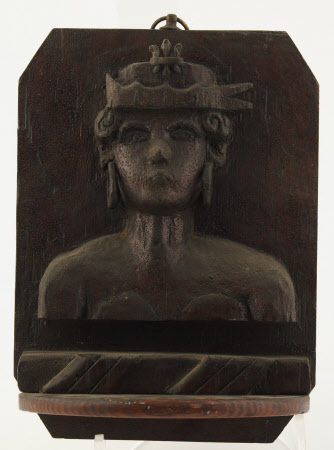Relief plaque with bust of a woman
British (English) School
Category
Wooden objects
Date
c. 1850
Materials
Stained wood
Measurements
260 x 195 x 100 mm
Place of origin
England
Order this imageCollection
Kingston Lacy Estate, Dorset
NT 1256047
Summary
Stained wood, relief plaque with bust, probably British (English) School, c. 1850. A wall plaque carved in high relief with a bust of a woman wearing the ceremonial cap and fleur-de-lis. Ostensibly after the Bankes heraldic charge described in the language of heraldry as a 'moor’s head, full-faced, couped at the shoulders proper, on the head a cap of maintenance gules, turned up ermine, adorned with a crescent, issuant therefrom a fleur-de-lis or’. The charge here is presumed to be female, and therefore distinct from the traditionally male manifestation of the charge. The plaque carved of wood and stained, supporting a semi-circular wooden tray perforated with holes, hung with a brass ring.
Full description
The head of a black person – sometimes crowned, sometimes ‘wreathed’ about the head – appears frequently as a motif (or charge) in medieval European heraldry. In the language of heraldry, the person depicted is described (or blazoned) as a ‘maure’, ‘moor’, ‘blackmoor’ or ‘blackamoor’, and the motif as ‘a maure’s head’ or ‘a moor’s head’, and so on. The term ‘maure’ derives from the Greek work ‘mauros’ meaning ‘black’ or ‘very dark’ and, in the medieval and early modern periods, was an ill-defined stereotype applied to Muslims of the Islamic Iberian Peninsula and North Africa. Usage developed to conflate Muslims of any ethnicity with black Sub-Saharan Africans. The image of the ‘moor’ or ‘blackamoor’ in European heraldry is itself usually stereotyped. Precisely when and where this motif was adopted as an heraldic charge is unknown, but the earliest example is thought to date from 11th century Italy. Its origins may lie in the invasion of Spain and Portugal in 711 by Africa and Arab Muslim forces. In Western Europe, the device may have referred to the black Egyptian St. Maurice, the patron saint of the Holy Roman Empire from the beginning of the 10th century, or to denote participation in the Crusades. Sometimes, in England, the device is used in what are known as ‘canting’ arms, and are incorporated into the arms of a family called ‘More’ or ‘More’, as a pun on their name. Several National Trust properties were, at one time in their history, owned by families whose coats of arms and/or crests incorporated ‘a moor’s head’ as an heraldic charge, and so it appears on objects which survive in National Trust collections. The arms of the Bankes family of Kingston Lacy, for instance, granted in 1613, were ‘a moor’s head, full-faced, couped at the shoulders proper, on the head a cap of maintenance gules, turned up ermine, adorned with a crescent, issuant therefrom a fleur-de-lis or’. ‘Moors’ heads’ also featured in the unofficial arms adopted by Richard Watt I (1724-96) the slave-owner and trader who bought Speke Hall in 1795 and who set up his arms in stained glass in one of the windows there. The term ‘moor’ is now considered anachronistic, but it remains part of heraldry’s descriptive vocabulary. It is used here in its historical and heraldic context.
Makers and roles
British (English) School, woodcarver
